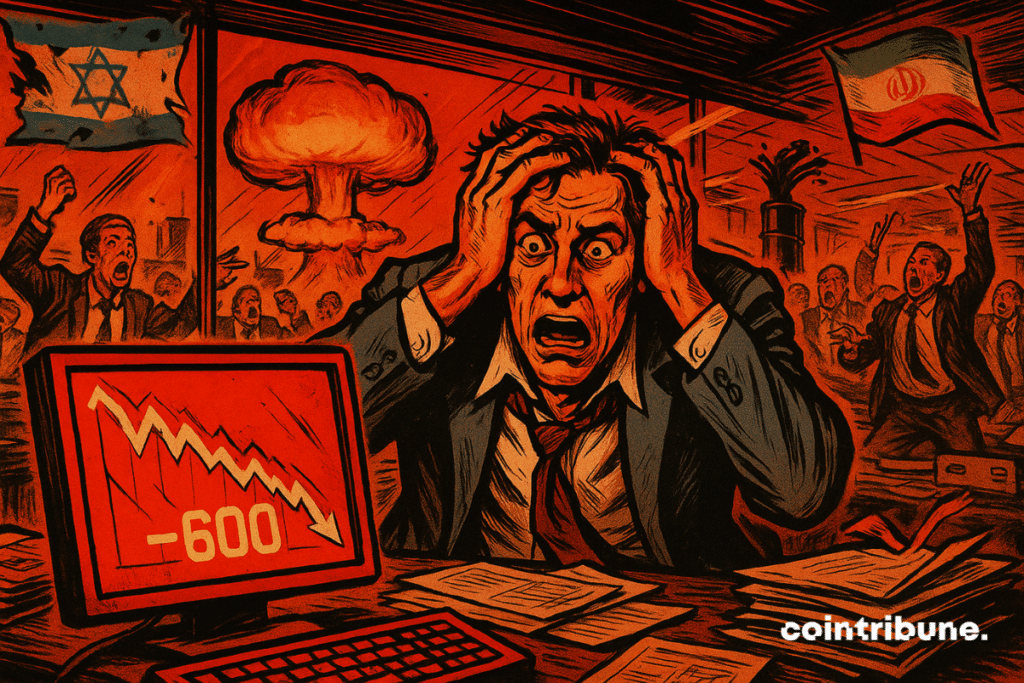Stock Market : The Dow Jones Falls By 600 Points After The Attack On Iran
The stock market has its moods, but sometimes it mostly has its fears. And this Friday, fear prevailed over everything else. An Israeli strike against Iran was enough to trigger an immediate shock on global markets, reminding everyone that indices are never entirely disconnected from the sound of bombs. In New York, the Dow Jones fell by more than 600 points right at the opening. A brutal collapse that owes nothing to chance, but everything to geopolitics. In this unstable equation, volatility has become the norm again, and the stock market a sounding board of the real world.

In Brief
- The Dow Jones plunged more than 600 points after an Israeli strike against Iran.
- Oil prices soared by more than 8%, rekindling inflation fears.
- Technology stocks fell, while energy and defense came out ahead.
A Geopolitical Shock That Reverses the Trend
The wake-up call was brutal on Wall Street. While markets showed fragile optimism, boosted by a technical recovery that began in early May, the stock market violently turned red. The cause: an Israeli strike against Iran, unexpected but heavy in consequences.
The Dow Jones, the historic barometer of the American economy, lost more than 600 points, nearly 1.4% in just a few hours. A lightning drop, revealing the maximum uncertainty atmosphere now weighing on investors.
The stock market, as often in times of geopolitical shock, played its role as a seismograph. But this time, the epicenter is neither economic nor monetary: it is military. The specter of a blaze-up in the Middle East was enough to abruptly reshape strategies. Technology stocks, spearheads of the spring rebound, were the first to be sacrificed. Tesla and Nvidia, until then locomotives of the Nasdaq, saw their gains melt away like snow in the sun.
This reaction is not emotional: it is defensive. Portfolio managers reduced their exposure to assets deemed risky to reposition themselves on so-called safe-haven assets like gold, or in sectors traditionally bullish in times of conflict, such as energy or defense.
Energy and Defense : The Winners of the Stock Market Panic
While red dominated the screens, some saw their curves ignite. Oil, first. Futures contracts on Brent and WTI crude jumped more than 8%, nearing 74 dollars per barrel. A violent rise, directly fueled by fears of supply route blockages in case of military escalation.
Subsequently, energy stocks soared. ExxonMobil and Chevron gained more than 2% and 1%, respectively. A classic market reflex in times of potential oil crisis, but also a signal: energy is becoming a major strategic issue again, far beyond simple yield logic.
Another sector heating up: defense. Lockheed Martin, a weapons giant, jumped about 3%. Military tensions reactivate expectations of rising defense budgets, particularly in the United States and its allies. Investors understood it well: in an unstable world again, the arms industry becomes a full-fledged safe-haven asset once more.
A Market Under Pressure, a Cloudy Future
The market reaction to the Israeli strike is all the more significant because it occurs in an already tense context. Persistent inflation, questions about the Fed’s future decisions, Chinese slowdown… The stock market didn’t need a new front. Yet it has one, particularly explosive.
Mark Malek, Chief Investment Officer at Siebert Financial, sums up the current mindset well: “This conflict adds challenges to already considerable market worries; they will not disappear.” And the inflationary impact of runaway oil prices should not be underestimated: any prolonged rise in energy prices could force the Fed to revise its monetary easing strategy.
On the political side, Donald Trump’s harsh intervention on Truth Social adds to the confusion. Through his ultimatums towards Iran and calls for negotiation, the former president sends mixed signals. Enough to further cloud short-term market outlooks and intensify the decline of Solana and Dogecoin.
Maximize your Cointribune experience with our "Read to Earn" program! For every article you read, earn points and access exclusive rewards. Sign up now and start earning benefits.

Fascinated by Bitcoin since 2017, Evariste has continuously researched the subject. While his initial interest was in trading, he now actively seeks to understand all advances centered on cryptocurrencies. As an editor, he strives to consistently deliver high-quality work that reflects the state of the sector as a whole.
The views, thoughts, and opinions expressed in this article belong solely to the author, and should not be taken as investment advice. Do your own research before taking any investment decisions.